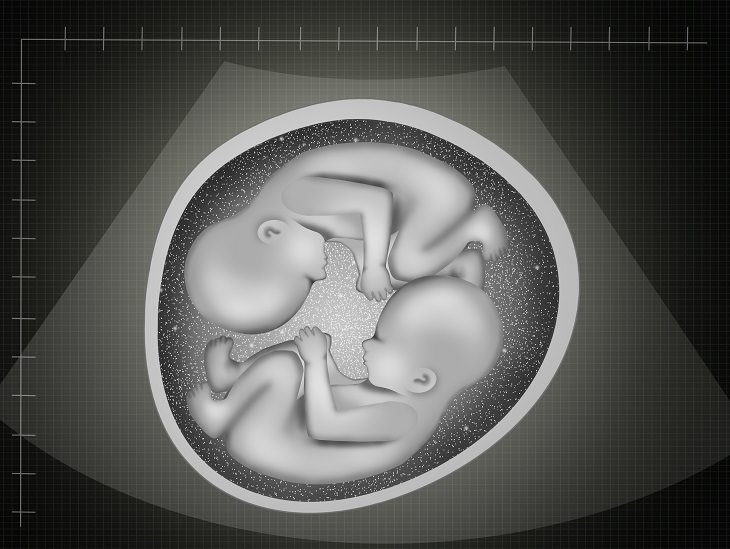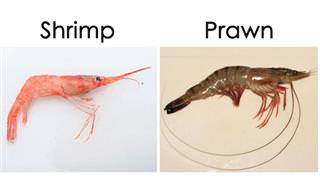
This is something you don’t hear about every day. Jessica Allen, a surrogate mother from California, expected to give birth to twins, but she was stunned to discover that one of the children was biologically her own.
This rare genetic mishap wasn’t noticed straight away, which resulted in both children being given away to parents. However, once Allen found out, she fought to get her child back.

It’s safe to assume that this was a shock for everyone involved, but how did it happen? Well, it’s all down to a process known as “superfetation.”
There are two types of surrogacy. During “traditional surrogacy,” the woman acting as the surrogate is artificially inseminated with the father’s sperm. The woman then carries the baby and gives birth to it. She’s technically the biological mother, but she gives the baby away to the couple to raise as their own.
However, in this case, it seems that Allen was a “gestational surrogate.” This involves using IVF techniques to take the eggs from the mother, fertilize them with sperm from the father, and then implanting them into the uterus of another woman, who carries the baby until it’s born.
In this scenario, the surrogate has no genetic link to the child, as her egg wasn’t used. She may be the “birth mother,” but she’s not the biological mother.
As reported by the BBC World Service program Newsday, Allen seems to have ovulated while pregnant, an incredibly rare occurrence. One fertilized egg was from the intended mother, while the other was Allen’s, which was also fertilized shortly after the surrogacy began.

When this was noted, doctors originally assumed that it was one embryo that had split into two, and the mistake went unnoticed until the pregnancy was long over. This additional ovulation is what is known as superfetation. It involves the formation of a new embryo from a separate pregnancy cycle while another from the original pregnancy cycle is already present and developing.
There is a risk of the second embryo being born prematurely, but fortunately, Allen avoided this fate. When both herself and the intended mother had doubts about the identity of one of the babies, a DNA test was ordered, and the results revealed that Allen was the genetic mother. However, legally, she wasn’t one of the parents, and it took her 10 months to get her son back.
Source: iflscience
Images: depositphotos

8 Mysterious Objects Found By Deep Sea Divers
The oceans are vast and mysterious, and they hide many strange and curious lost objects. Here are 8 such items, unearthed by deep-sea divers.
 5:45
5:45
Why Ingesting This Seemingly Innocent Plant is ILLEGAL
The Peyote, also known as the button cactus (for its cute button-like shape, of course), is not as innocent and harmless as it may seem.

The Weird and Wonderful History of Perfume!
Perfume has been around for centuries and this article takes a look at its strange history.
 12:10
12:10
How Did We Invent the Dollar? Learn Its Meandering History
In this video, we will learn a short history of the U.S. Dollar.

8 Surprising Things You Can Be Allergic To
Did you ever dislike something so much you joked you're allergic to it? Turns out some people actually suffer from the strangest allergies...
 9:09
9:09
15 Bizarre Looking Insects and How to Behave Around Them
This video will introduce you to 15 of the most strange-looking bugs in nature, alongside some tips on how to behave around them to stay safe.

18 Films That Remind Us How Brutal Winter Can Be
Winter isn’t as cozy as you might think. These cold-weather survival movies will make you long for summer days.

Millennials Are Killing These 12 Industries...
The preferences of millennials are destroying dozens of industries. Here are 12 industries that they're killing.

18 of the Most Incredibly-Timed Photos You'll Ever See
These photos will leave you in awe of their timing. The visual impact they have is staggering. Take a look at these 18 images.

The True Scale of These Things Will Really Surprise You!
Did you know that there are actually a lot of things in our world that are far bigger in reality than most people would expect. Here of 20 of them.

These Photos Will Help Restore Your Faith in Humanity!
These pictures will surely put a smile on your face, and they may even make you cry tears of happiness. However, most importantly, we hope they inspire you.

8 Essential Greek Philosophy Books You Shouldn't Miss
Here is your best chance for understanding Greek philosophy and its history.
 46:36
46:36
50 Years On, Looking Back at the Great Train Robbery
The Great Train Robbery was one of the greatest heists in British history. This documentary could be the last chance to find out the answers everyone wants...

14 Nostalgic Pics to Take You Back to the Good Ol’ Days
These photos will instantly trigger your nostalgia.

The Incredible Story of a Boy Surviving 49 Days at Sea!
This Indonesian teenager managed to survive almost 50 days at sea while adrift in a floating wooden hut. Learn all about his amazing story here.

These Rare Photos Tell the Story of the Great Depression
A photographic summary depiction of The Great Depression.

5 Assassinations of World Leaders that Shook the World
Read through these five infamous assassinations of world leader shook the world.

22 Old Photos That Really Make History Come Alive
Looking through these old black and white photos you can really learn a lot about history and the world. These 22 photos generates that mind-blowing spark and teaches you something new.

The Most Insightful Quotes From the Mind of Albert Einstein
Allow me to share some of the insightful quotes that came out of Albert Einstein's head
 9:28
9:28
Take a Look At the Many Secrets of Life in Ancient Egypt
Ancient Egypt always fascinates us. But do we really know how daily life in that civilization was like? Watch his video to learn more.

From Food to Science - The WORST Misnomers You’ll Find!
Whoever named these objects must have seriously run out of imagination!

23 Extraordinary Vision Facts That'll Open Your Eyes Wide
The eye is an amazing body part, but did you know how amazing? These 23 facts will open your eyes to the extraordinary truth.

These Tips Will Help You Start Reading Again
Reading skills not as strong as they were in the days of yore? Here are my tried-and-true tips to help you get back on the reading horse.

18 Unlikely But True Facts That Will Get You Thinking
The saying truth is stranger than fiction is all too true when you read these incredible facts. #2 had me grabbing for my calculator.

7 Downsides to Being Highly Intelligent
Everyone thinks that being blessed with a very high IQ can only be positive, but there are also downsides. Here are 7 downsides to being highly intelligent.
 15:14
15:14
Ancient Technologies That Remain a Complete Mystery
Scientists may have solved the mystery of Egyptian pyramids, but there are still so many findings that are left completely unexplained

There is No Greater Blessing than Your Family
Beautiful Words: Having a family to care for is a blessing.
 8:23
8:23
Learning to Trust Again - Rehabilitating an Abused Dog
Ralph the abandoned dog learns to trust again...

20 Unforgettable Last Words Spoken By Famous People
There’s something poignaant about reading famous last words.

Dogs Can Teach Us a Lot About Friendship...
While dogs may be man's best friend, dogs’ best friends are undoubtedly other dogs, as these adorable pictures go to show.

Check Out These Rare and Fascinating Antonyms!
Here are a few rare but fascinating antonyms we wish people used more often.

7 Ancient Buildings That Have Survived the Test of Time
Here is a look at some wonderful ancient structures that have survived the test of time.

I Just Wanted to Remind You: You're the BEST!
Do you know someone who ought to be given some appreciation? Make their day today by congratulating them with a sweet compliment!

Beware of Ordering These (Potentially) Fake Foods
There are certain items on a restaurant's menu that should be considered with caution, and this is because they tend to be faked. Learn more here.

How We Came to Play: The Origins of Playground Games
The fun games we played in our childhood had some interesting origins.

I Just Wanted to Say: Have a MERRY CHRISTMAS!
Choose from our lovely selection of greeting cards and share your deepest wishes with your friends and family, to celebrate this blessed time of the year!

20 Things Most People Think Are the Same, But Aren't!
These words are often mistaken for synonyms, but in reality they are nothing of the sort, because they refer to different things. Learn about 20 of them.,

The Dark and Fascinating History of the Romanov Family
For more than three hundred years, the Romanov family had absolute power over Russia, this is their fascinating story.
 12:09
12:09
Witness How Cinema's Visual Effects Changed With Time
Witness the progression of visual effects in cinema from the Academy Awards of 1927 and moving all the way up to 2018's edition.

6 Short Stories to Help You Stay Motivated in Life
If you’re feeling down, rather than surf the internet for cat pictures or drowning your sorrows by reading junk, check out these inspirational and powerful Short Stories

Learn Something New Today with These 10 Intriguing Tidbits...
These random facts will make you think twice about a couple of things - and some will certainly be hard to believe.

Shocking! These Are the Rules That Pirates Had to Obey!
Pirates are often imagined as living a life of adventure, free from the shackles of society. However, they did have rules of their own, and here are 10 of them.

After Reading This, You'll Want to Move to Finland!
This article takes a look at how the Finnish government makes ordinary life extremely comfortable for its citizens.

You'll Need a Second Look For THESE Photos...
These fascinating photo illusions will make you believe like you're seeing one thing, but they actually depict something very different

10 of the Most Spectacular Royal Crowns in the World
Crowns have long been seen as a strong symbol of power and wealth. Here are some of the world's most recognized crowns and tiaras.

News That Inspires: Positive Stories From Around the World
There are so many good things happening in the world. Here’s a look at some of the most inspiring news updates to brighten your day.

You'd Best Think Twice Before Consuming These Delicacies!
Here are 10 dishes that can give you an adrenaline rush stronger than that from any roller-coaster, while testing your luck better than the lottery.


